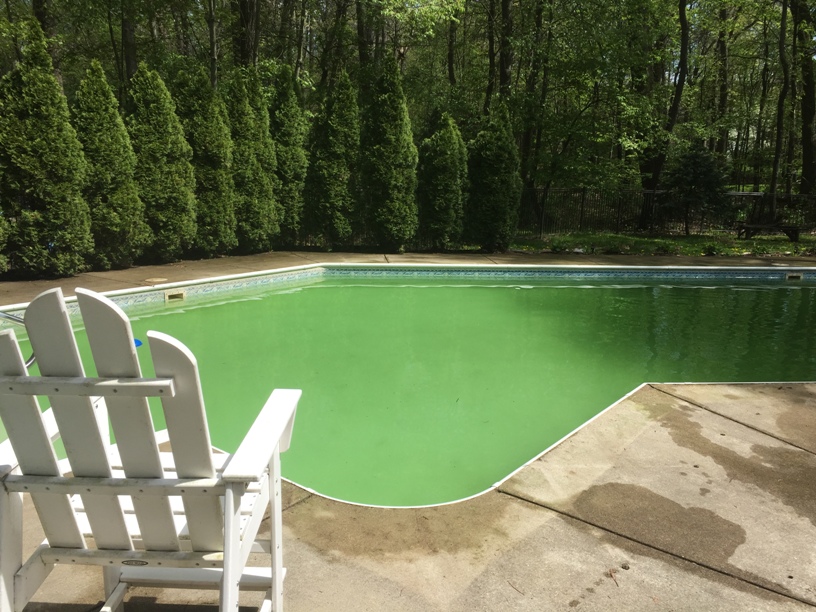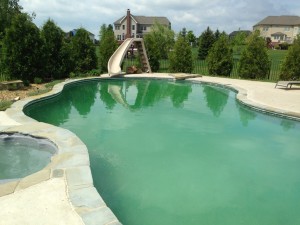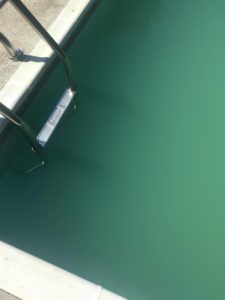
Algae is often the simplest and most assumed idea when a swimming pool starts to turn green. This can be the cause in many cases, especially if sanitizer levels are allowed to drop. There are many other reasons why a pool may turn green, and this week on the world stage we are seeing one of them unfold.

At Ask the Pool Guy HQ, we recently had an in depth conversation about water chemistry and swimming pools based on the photos and information that is being shared online about the Olympic pools. Here is some information about why this is a simple and at the same time very complex issue, as it deals with water chemistry and keeping everything in balance.

Water chemistry is an exact science, though a change of one element may cause a other levels to change based on how different measurable parts of the water interact with one another. There are water tests that help determine the exact levels in the pool water, taken from a sample. Changing one element in the makeup of the water chemistry has an effect on the other chemicals, which is why adjustments take time. In any pool water chemistry adjustment chemicals need to be added in correct doses, the water allowed to circulate (sometimes as little as 2 hours between tests and adjustments, and sometimes 12-24 hours to see accurate changes), and then re-test to see if further additions are needed.
The Langelier Saturation Index (LSI) is a calculator to use when determining if the water is balanced, corrosive, or scale forming. Source
We are not familiar with the plumbing or filtration systems of the pools turning green in Rio (would love to see a photo if anyone has access!) however, we are familiar with various shades of water, water clarity, and what they often mean.
When we approach water we take into consideration what we are seeing and then we follow our theories with water testing to confirm what we think is happening.
Some results of the balance of water can also be felt. When slime begins to form on surfaces it is often from algae. If the pool surface feels sandy or granular it is often the result of high pH or high alkalinity causing scale, which is pushing calcium (minerals) out of the water to deposit on pool surfaces. Pool water with a high pH will also often result in a dry chalky residue forming on the skin after exiting the pool, and the walls can begin to feel slippery as well. High pH will also often begin to cause cloudy water in a pool.
The first photos of the dive pool were of a very fluorescent green yet very clear (you could see the bottom), which is often seen when the pH and alkalinity in a swimming pool get too high – especially where metals may be present in the water such as iron or copper, either from source water or if the water chemistry levels have been off (too low) causing corrosion of any metal elements of the pool structure, or of the equipment, especially if a heater is on the pool to control temperature. Many heater cores are made from copper which can corrode and leech into the water.
When we give advice we tend to give a tight range for water chemistry numbers. For optimal swimmer/bather comfort the pH is suggested to be 7.4-7.6 (this opinion varies depending on who is offering the advice, and the range is a bit wider provided by most chemical manufacturers). In addition to the pH, the alkalinity which buffers the pH, we suggest be kept at a range of 80-100ppm, in a salt water pool. Many competition pools are now using salt water/chlorine generating systems to create a constant flow of chlorine into the pool. This constant creation of chlorine keeps a steady level of chlorine, it also tends to increase the pH of pool water, especially if alkalinity runs on the high end of the recommended range. Chlorine can have a pH level of 11+, and if the suggested pH is 7.4 you can see how the increase constantly added to the pool could create an increase in the overall pH of the water. Many salt water pool systems also have automatic acid dispensing to disperse a small amount of acid to counter act or negate the increase in pH and keep the water in stable ranges. If the acid ran out, it would explain the continued chlorination of the water, and increase in pH levels.
When pH increases the water will also change and any metals that are dissolved in the water, which could be from source water with iron content or copper based pool products such as algae prevention would become suspended in the water and visible to the eye – hence the green yet clear water.
Changes in water chemistry are always gradual and rarely can you correct an issue instantly. Source water, such as what was used to fill the Olympic pools would need to be tested to determine the water chemistry ranges of the source. Some source water can have very alkaline readings, and to lower the levels would take many treatments to get the water in range.
To reduce the pH or alkalinity in a pool muriatic acid which is a liquid hydrochloric or dry acid which is sodium bisulphate. Most chemical manufacturers suggest adding less than you think you will need when adjusting pool water, because when the water starts to change it may over correct itself, again based on water chemistry and how each part relates to another.
If the officials attempted a “quick fix” and overdosed the pool the result could be the pH going too low – which is often visible with murky almost metallic – green looking water. This would also explain why no swimmers were allowed in the pool, and why the pool filtration system would have been turned off – common practice when adjusting pH levels.

A couple of common misconceptions are if you smell chlorine, that means there is too much in the pool. It is often the opposite. When chlorine does it’s job and combine with contaminants brought into the pool such as urine, perspiration, body oils, cosmetics, as well as natural elements that may blow into a pool, the result is chloramines, and those are what often cause the smell. Once chloramines are present, the chlorine that is bonded is essentially used up and more chlorine must be added to continue to sanitize the water. Source
Our website has some simple water chemistry information as well: Ask the Pool Guy
